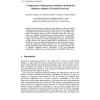Free Online Productivity Tools
i2Speak
i2Symbol
i2OCR
iTex2Img
iWeb2Print
iWeb2Shot
i2Type
iPdf2Split
iPdf2Merge
i2Bopomofo
i2Arabic
i2Style
i2Image
i2PDF
iLatex2Rtf
Sci2ools
AMR
2007
Springer
2007
Springer
Comparison of Dimension Reduction Methods for Database-Adaptive 3D Model Retrieval
Distance measures, along with shape features, are the most critical components in a shape-based 3D model retrieval system. Given a shape feature, an optimal distance measure will vary per query, per user, or per database. No single, fixed distance measure would be satisfactory all the time. This paper focuses on a method to adapt distance measure to the database to be queried by using learning-based dimension reduction algorithms. We experimentally compare six such dimension reduction algorithms, both linear and non-linear, for their efficacy in the context of shape-based 3D model retrieval. We tested the efficacy of these methods by applying them to five global shape features. Among the dimension reduction methods we tested, non-linear manifold learning algorithms performed better than the other, e.g. linear algorithms such as principal component analysis. Performance of the best performing combination is roughly the same as the top finisher in the SHREC 2006 contest.
| Added | 07 Jun 2010 |
| Updated | 07 Jun 2010 |
| Type | Conference |
| Year | 2007 |
| Where | AMR |
| Authors | Ryutarou Ohbuchi, Jun Kobayashi, Akihiro Yamamoto, Toshiya Shimizu |
Comments (0)

